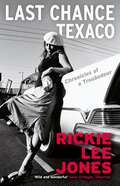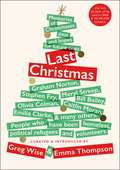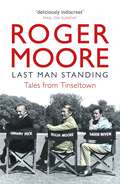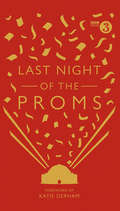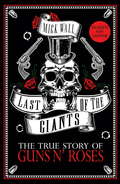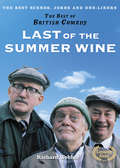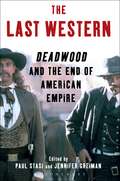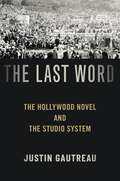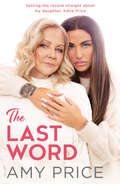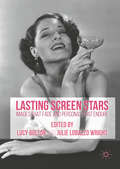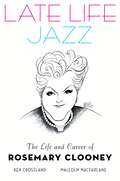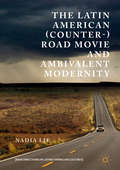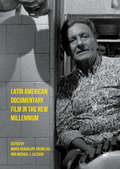- Table View
- List View
Last Chance Texaco: Chronicles of a Troubadour
by Rickie Lee JonesThis troubadour life is only for the fiercest hearts, only for those vessels that can be broken to smithereens and still keep beating out the rhythm for a new song.Last Chance Texaco is the first-ever no-holds-barred account of the life of two-time Grammy Award-winner Rickie Lee Jones, in her own words. It is a tale of desperate chances and impossible triumphs, an adventure story of a girl whobeat the odds and grew up to become one of the most legendary artists of her time, turning adversity and hopelessness into timeless music.With candour and lyricism, the 'Duchess of Coolsville' (Time) takes us on a singular journey through her nomadicchildhood, to her years as a teenage runaway, through her legendary love affair with Tom Waits, and ultimately herlongevity as the hardest working woman in rock and roll. Rickie Lee's stories are rich with the infamous characters of her early songs - 'Chuck E's in Love,' 'Weasel and the White Boys Cool,' 'Danny's All-Star Joint' and 'Easy Money' - but long before her notoriety in show business, there was a vaudevillian cast of hitchhikers, bank robbers, jail breaks, drug mules, a pimp with a heart of gold, and tales of her fabled ancestors.In this electrifying and intimate memoir by one of the most remarkable, trailblazing and tenacious women in musicare never-before-told stories of the girl in the raspberry beret, a singer-songwriter whose music defied categorization and inspired pop culture for decades.
Last Christmas: Memories Of Christmases Past And Hopes Of Future Ones
by Emma Thompson Greg WiseThe perfect gift book, featuring the writing of Meryl Streep, Bill Bailey, Emilia Clarke, Olivia Colman, Caitlin Moran, Richard Ayoade, Emily Watson and others, to coincide with the upcoming movie Last Christmas, starring Emma Thompson, Emilia Clarke and Henry Golding.When you think back to Christmases past, what (if anything) made it magical? Looking towards the future, what would your perfect Christmas be? What would you change? What should we all change?This is a beautiful, funny and soulful collection of personal essays about the meaning of Christmas, written by a unique plethora of voices from the boulevards of Hollywood to the soup kitchens of Covent Garden.Away from the John Lewis advert, the high street decorations and the candied orange in Heston Blumenthal's Christmas pudding, this gem of a book introduced and curated by Emma Thompson and Greg Wise celebrates the importance of kindness and generosity, acceptance and tolerance - and shows us that these values are not just for Christmas.
Last Man Standing: Tales from Tinseltown
by Roger MooreIn a career that spans over seven decades, Roger Moore has been at the very heart of the show-business scene. We all know him as an actor who has starred in films that have made him famous the world over, but he's also a tremendous prankster, joker and raconteur - in fact, he's well known as one of the nicest guys in the business, and someone who has always been up for some fun.In this fabulous collection of true stories from his stellar career, Roger lifts the lid on the movie business, from Hollywood to Pinewood. It features outrageous tales from his own life and career as well as those told to him by a host of stars and filmmakers, including Tony Curtis, Sean Connery, Michael Caine, David Niven, Frank Sinatra, Gregory Peck, John Mills, Peter Sellers, Michael Winner, Cubby Broccoli and many more. Wonderfully entertaining and laugh-out-loud fu
Last Night of the Proms: An Official Miscellany
by Katie DerhamThe ultimate celebration of the world’s favourite classical knees-up!With a foreword from Katie DerhamEver since Sir Henry Wood’s Proms were first broadcast in 1927, Last Night has become an annual appointment for classical music lovers and is enjoyed by millions around the world. This first and official miscellany explores the history and traditions that have developed on the last night of the world’s biggest and longest-running classical music festival. Learn about the origins of the Proms and how it first got its name. Discover the stories behind iconic Last Night songs such as ‘Land of Hope and Glory’, ‘Jerusalem’ and ‘Fantasia on British Sea Songs’, and prepare to Prom with our dos and don’ts guide for Last Night Prommers.From flag waving and ‘Rule, Britannia’ to the most memorable conductors’ speeches, and the story of how the Proms survived the Blitz, Last Night of the Proms: An Official Miscellany, is the perfect tribute to a uniquely British institution.
Last of the Giants: The True Story of Guns N' Roses
by Mick WallINCLUDES BRAND NEW CHAPTER COVERING GUNS N' ROSES EPIC WORLD TOURMany millions of words have already been written about Guns N' Roses, the old line-up, the new line-up. But none of them have ever really gotten to the truth. Which is this: Guns N' Roses has always been a band out of time, the Last of the Giants. They are what every rock band since the Rolling Stones has tried and nearly always failed to be: dangerous. At a time when smiling, MTV-friendly, safe-sex, just-say-no Bon Jovi was the biggest band in the world, here was a band that seemed to have leapt straight out of the coke-smothered pages of the original, golden-age, late-sixties rock scene.'Live like a suicide', the band used to say when they all lived together in the Hell House, their notorious LA home. And this is where Mick Wall first met them, and became part of their inner circle, before famously being denounced by name by Axl Rose in the song 'Get in the Ring'.But this book isn't about settling old scores. Written with the clear head that 25 years later brings you, this is a celebration of Guns N' Roses the band, and of Axl Rose the frontman who really is that thing we so desperately want him to be: the last of the truly extraordinary, all-time great, no apologies, no explanations, no giving-a-shit rock stars. The last of his kind.
Last of the Summer Wine (The Best of British Comedy)
by Richard WebberThe best jokes, gags and scenes from a true British comedy classic. ‘Do you reckon I’m in love with Mrs. Batty, or is it just sex?’ Compo
The Last Storytellers: Tales from the Heart of Morocco
by Richard HamiltonMarrakech is the heart and lifeblood of Morocco's ancient storytelling tradition. For nearly a thousand years, storytellers have gathered in the Jemaa el Fna, the legendary square of the city, to recount ancient folktales and fables to rapt audiences. But this unique chain of oral tradition that has passed seamlessly from generation to generation is teetering on the brink of extinction. The competing distractions of television, movies and the internet have drawn the crowds away from the storytellers and few have the desire to learn the stories and continue their legacy. Richard Hamilton has witnessed at first hand the death throes of this rich and captivating tradition and, in the labyrinth of the Marrakech medina, has tracked down the last few remaining storytellers, recording stories that are replete with the mysteries and beauty of the Maghreb.
Last Train to Hilversum: A journey in search of the magic of radio
by Charlie ConnellyDespite the all-pervading influence of television ninety per cent of people in Britain still listen to the radio, clocking up over a billion hours of listening between us every week. It's a background to all our lives: we wake up to our clock radios, we have the radio on in the kitchen as we make the tea, it's on at our workplaces and in our cars. From Listen With Mother to the illicit thrill of tuning into pirate stations like Radio Caroline; from receiving a musical education from John Peel or having our imagination unlocked by Douglas Adams' The Hitchhiker's Guide to the Galaxy; from school-free summers played out against a soundtrack of Radio One and Test Match Special to more grown-up soundtracks of the Today programme on Radio 4 and the solemn, rhythmic intonation of the shipping forecast – in many ways, our lives can be measured in kilohertz.Yet radio is changing because the way we listen to the radio is changing. Last year the number of digital listeners at home exceeded the number of analogue listeners for the first time, meaning the pop and crackle and the age of stumbling upon something by chance is coming to an end. There will soon be no dial to turn, no in-between spaces on the waveband for washes of static, mysterious beeps and faint, distant voices. The mystery will be gone: we'll always know exactly what it is we're listening to, whether it's via scrolling LCD on our digital radios, the box at the bottom of our TV screen or because we've gone in search of a particular streaming station. And so, as the world of analogue listening fades, Charlie Connelly takes stock of the history of radio and its place in our lives as one of the very few genuinely shared national experiences. He explores its geniuses, crackpots and charlatans who got us to where we are today, and remembers its voices, personalities and programmes that helped to form who we are as individuals and as a nation. He visits the key radio locations from history, and looks at its vital role over the past century on both national and local levels. Part nostalgic eulogy, part social history, part travelogue, Last Train To Hilversum is Connelly's love letter to radio, exploring our relationship with the medium from its earliest days to the present in an attempt to recreate and revisit the world he entered on his childhood evenings on the dial as he set out on the radio journey of a lifetime.
The Last Western: Deadwood and the End of American Empire
by Paul Stasi Jennifer GreimanPerhaps the most sophisticated and complex of shows in HBO's recent history, Deadwood has surprisingly little coverage in our current scholarship. Grounding contemporary anxieties about race and class, domesticity and American exceptionalism in its nineteenth-century setting, Deadwood revises our understanding of a formative period for the American nation through a re-examination of one of the main genres through which this national story has been transmitted: the Western. With contributions from scholars in American studies, literature, and film and television studies, The Last Western situates Deadwood in the context of both its nineteenth-century setting and its twenty-first-century audience. Together, these essays argue for the series as a provocative meditation on both the state and historical formation of U.S. empire, examining its treatment of sovereign power and political legitimacy, capital accumulation and dispossession, racial and gender identities, and social and family structures, while attending to the series' peculiar and evocative aesthetic forms. What emerges from this collection is the impressive range of Deadwood's often contradictory engagement with both nineteenth and twenty-first century America.
The Last Western: Deadwood and the End of American Empire
by Paul Stasi Jennifer GreimanPerhaps the most sophisticated and complex of shows in HBO's recent history, Deadwood has surprisingly little coverage in our current scholarship. Grounding contemporary anxieties about race and class, domesticity and American exceptionalism in its nineteenth-century setting, Deadwood revises our understanding of a formative period for the American nation through a re-examination of one of the main genres through which this national story has been transmitted: the Western. With contributions from scholars in American studies, literature, and film and television studies, The Last Western situates Deadwood in the context of both its nineteenth-century setting and its twenty-first-century audience. Together, these essays argue for the series as a provocative meditation on both the state and historical formation of U.S. empire, examining its treatment of sovereign power and political legitimacy, capital accumulation and dispossession, racial and gender identities, and social and family structures, while attending to the series' peculiar and evocative aesthetic forms. What emerges from this collection is the impressive range of Deadwood's often contradictory engagement with both nineteenth and twenty-first century America.
The Last Word: The Hollywood Novel and the Studio System
by Justin GautreauThe Last Word argues that the Hollywood novel opened up space for cultural critique of the film industry at a time when the industry lacked the capacity to critique itself. While the young studio system worked tirelessly to burnish its public image in the wake of celebrity scandal, several industry insiders wrote fiction to fill in what newspapers and fan magazines left out. Throughout the 1920s and 1930s, these novels aimed to expose the invisible machinery of classical Hollywood cinema, including not only the evolving artifice of the screen but also the promotional discourse that complemented it. As likeminded filmmakers in the 1940s and 1950s gradually brought the dark side of the industry to the screen, however, the Hollywood novel found itself struggling to live up to its original promise of delivering the unfilmable. By the 1960s, desperate to remain relevant, the genre had devolved into little more than erotic fantasy of movie stars behind closed doors, perhaps the only thing the public couldn't already find elsewhere. Still, given their unique ability to speak beyond the institutional restraints of their time, these earlier works offer a window into the industry's dynamic creation and re-creation of itself in the public imagination.
The Last Word
by Amy PriceRaw and unflinching This is a mother’s account of her daughter’s life And of Katie Price and her turbulent rise to fame
LAST WORD C: The Hollywood Novel and the Studio System
by Justin GautreauThe Last Word argues that the Hollywood novel opened up space for cultural critique of the film industry at a time when the industry lacked the capacity to critique itself. While the young studio system worked tirelessly to burnish its public image in the wake of celebrity scandal, several industry insiders wrote fiction to fill in what newspapers and fan magazines left out. Throughout the 1920s and 1930s, these novels aimed to expose the invisible machinery of classical Hollywood cinema, including not only the evolving artifice of the screen but also the promotional discourse that complemented it. As likeminded filmmakers in the 1940s and 1950s gradually brought the dark side of the industry to the screen, however, the Hollywood novel found itself struggling to live up to its original promise of delivering the unfilmable. By the 1960s, desperate to remain relevant, the genre had devolved into little more than erotic fantasy of movie stars behind closed doors, perhaps the only thing the public couldn't already find elsewhere. Still, given their unique ability to speak beyond the institutional restraints of their time, these earlier works offer a window into the industry's dynamic creation and re-creation of itself in the public imagination.
The Lasting Influence of the War on Postwar British Film
by M. BoyceMany of the most celebrated British films of the immediate post-war period (1945-55) seem to be occupied with "getting on" with life and offering distraction for postwar audiences. It is the time of the celebrated Ealing comedies, Hue and Cry (1946) and Kind Hearts and Coronets (1949), Dickens adaptations, and the most ambitious projects of the Archers. While the war itself is rarely mentioned in these films, the war and the conditions of postwar society lie at the heart of understanding them. While various studies have focused on lesser known realist films, few consider how deeply and completely the war affected British film. Michael W. Boyce considers the preoccupation of these films with profound anxieties and uncertainties about what life was going to be like for postwar Britain, what roles men and women would play, how children would grow up, even what it meant - and what it still means today - to be British.
Lasting Screen Stars: Images that Fade and Personas that Endure
by Lucy Bolton Julie Lobalzo WrightLasting Stars examines the issue of stardom and longevity and investigates the many reasons for the persistence or disappearance of different star personas. Through a selection of chapters that look at issues such as inappropriate ageing, national identity and physical characteristics, this book will be the first volume to consider in depth and breadth the factors that affect the longevity of film stardom.The range of stars includes popular stars who are approached from fresh angles (Brando, Loren), less popular stars whose lower-profiles than their peers may be surprising (Taylor, Shearer) and stars whose national identity is integral to their perception as they age (Riva, Bachchan, Pavor). There are stars from the beginning of Hollywood (Valentino, Reid) to the present day (Jolie), and those who made uneasy transitions between countries (Mason), ages (Ringwald) and industrial eras (Keaton). The book examines the range of factors that affect how star images endure, including appropriate and inappropriate ageing (Griffith), race (Ice Cube) and digital technologies (Lee).
L'Atalante (BFI Film Classics)
by Marina WarnerL'Atalante is the work of French director Jean Vigo. It is a study of romantic love, told in a style influenced by surrealism, but still Vigo's own. This text is part of the 'BFI Film Classics' series. Each volume in the series presents a personal commentary on the film, together with a brief production history and a detailed filmography, notes and bibliography.
L'Atalante (BFI Film Classics)
by Marina WarnerL'Atalante is the work of French director Jean Vigo. It is a study of romantic love, told in a style influenced by surrealism, but still Vigo's own. This text is part of the 'BFI Film Classics' series. Each volume in the series presents a personal commentary on the film, together with a brief production history and a detailed filmography, notes and bibliography.
The Late Films of Claude Chabrol: Genre, Visual Expressionism and Narrational Ambiguity
by Jacob LeighA member of the French New Wave group of filmmakers who first came to prominence at the end of the 1950s, Claude Chabrol has received the least amount of critical and scholarly attention, although he was the more prolific and commercially successful of them all. Jacob Leigh fills this lacuna by focusing on the last nine feature films of Chabrol's career, exploring his imagery, camerawork, use of sound and music, and performances, revealing the stylistic characteristics of his films while identifying the fundamental thematic issues that lie at the heart of his career-length exploration of the relationship between individuals and societies. Key areas of focus includes Chabrol's careful depiction of upper-class settings in films such as La Cérémonie (1995), Merci pour le chocolat (2000) and La Fille coupée en deux (2007) and on what Robin Wood and Michael Walker call 'the beast in man' (1970), the quasi-sympathetic 'id-figures' of which Le Boucher's Popaul is the most celebrated. Chabrol's 'id-figures' inherit the traits of Shadow of a Doubt's Uncle Charlie, Rope's Brandon and Strangers on a Train's Bruno, all three of whom have characteristics of the Nietzsche-quoting psychopath familiar in crime fiction. Additionally, The Late Films of Claude Chabrol considers the influence on Chabrol of a range of significant writers, including Patrick Hamilton, Patricia Highsmith, Charlotte Armstrong and Ruth Rendell.
The Late Films of Claude Chabrol: Genre, Visual Expressionism and Narrational Ambiguity
by Jacob LeighA member of the French New Wave group of filmmakers who first came to prominence at the end of the 1950s, Claude Chabrol has received the least amount of critical and scholarly attention, although he was the more prolific and commercially successful of them all. Jacob Leigh fills this lacuna by focusing on the last nine feature films of Chabrol's career, exploring his imagery, camerawork, use of sound and music, and performances, revealing the stylistic characteristics of his films while identifying the fundamental thematic issues that lie at the heart of his career-length exploration of the relationship between individuals and societies. Key areas of focus includes Chabrol's careful depiction of upper-class settings in films such as La Cérémonie (1995), Merci pour le chocolat (2000) and La Fille coupée en deux (2007) and on what Robin Wood and Michael Walker call 'the beast in man' (1970), the quasi-sympathetic 'id-figures' of which Le Boucher's Popaul is the most celebrated. Chabrol's 'id-figures' inherit the traits of Shadow of a Doubt's Uncle Charlie, Rope's Brandon and Strangers on a Train's Bruno, all three of whom have characteristics of the Nietzsche-quoting psychopath familiar in crime fiction. Additionally, The Late Films of Claude Chabrol considers the influence on Chabrol of a range of significant writers, including Patrick Hamilton, Patricia Highsmith, Charlotte Armstrong and Ruth Rendell.
Late Life Jazz: The Life and Career of Rosemary Clooney
by Ken Crossland Malcolm MacfarlaneWhen people hear the name "Clooney," they automatically think of George Clooney, one of Hollywood's biggest stars. But it was his aunt Rosemary who first catapulted the name into bright lights with a string of hit songs in the 1950s and a starring role alongside Bing Crosby in the immortal "White Christmas." Drawing on interviews with family members, managers, promoters, and the jazz musicians who worked with her, as well as contemporary newspaper articles and reviews, Late Life Jazz tells the unsung story of one of America's finest singers, Rosemary Clooney. Ken Crossland and Malcolm Macfarlane trace Rosemary's life from her hardscrabble beginnings in Maysville Kentucky, through her first performances singing with the Barney Rapp Band in Cincinnati, through her rise to pop stardom in the early 1950s when she topped the Hit Parade with songs such as "Come On-a My House," "Tenderly," and "Half As Much." By the time the 1960s arrived, however, personal turmoil, fueled by depression and an addiction to prescription medication, almost destroyed Clooney's career-and her life. She underwent years of therapy and recuperation before she was able to perform again in the early 1970s. Few expected her to be anything more than a baroness of nostalgia, but Rosemary had other ideas. Rejuvenated by a series of concerts alongside her friend and mentor, Bing Crosby, she found a new medium in the midst of America's finest jazz musicians, building a second career and with it a reputation as one of the finest interpreters of the Great American Songbook. Vividly written and painstakingly researched, Late Life Jazz explores the rise, fall, and final triumph of Clooney the First, Aunt Rosemary, jazz singer par excellence.
Late Life Jazz: The Life and Career of Rosemary Clooney
by Ken Crossland Malcolm MacfarlaneWhen people hear the name "Clooney," they automatically think of George Clooney, one of Hollywood's biggest stars. But it was his aunt Rosemary who first catapulted the name into bright lights with a string of hit songs in the 1950s and a starring role alongside Bing Crosby in the immortal "White Christmas." Drawing on interviews with family members, managers, promoters, and the jazz musicians who worked with her, as well as contemporary newspaper articles and reviews, Late Life Jazz tells the unsung story of one of America's finest singers, Rosemary Clooney. Ken Crossland and Malcolm Macfarlane trace Rosemary's life from her hardscrabble beginnings in Maysville Kentucky, through her first performances singing with the Barney Rapp Band in Cincinnati, through her rise to pop stardom in the early 1950s when she topped the Hit Parade with songs such as "Come On-a My House," "Tenderly," and "Half As Much." By the time the 1960s arrived, however, personal turmoil, fueled by depression and an addiction to prescription medication, almost destroyed Clooney's career-and her life. She underwent years of therapy and recuperation before she was able to perform again in the early 1970s. Few expected her to be anything more than a baroness of nostalgia, but Rosemary had other ideas. Rejuvenated by a series of concerts alongside her friend and mentor, Bing Crosby, she found a new medium in the midst of America's finest jazz musicians, building a second career and with it a reputation as one of the finest interpreters of the Great American Songbook. Vividly written and painstakingly researched, Late Life Jazz explores the rise, fall, and final triumph of Clooney the First, Aunt Rosemary, jazz singer par excellence.
Lateinamerikaberichterstattung der deutschen Presse: Struktur und Entstehungsbedingungen
by Regina CazzamattaDas vorliegende Buch zu Struktur und Entstehungsbedingung Lateinamerikas in der deutschen Presse basiert auf einer in dieser Dimension bis heute nicht vorhandenen empirischen Grundlage. Die Studie basiert auf 21.929 Beiträgen, von denen mithilfe einer geschichteten Stichprobe 4.164 in die Analyse einbezogen, ausgewertet und mit Korrespondenten-Interviews kombiniert wurden. Sie beleuchtet die Auswahlkriterien und Mechanismen der Berichterstattung zu Lateinamerika und füllte eine Forschungslücke zu einem Thema, das außenpolitisch extrem relevant ist. Das Buch betrachtet Themen und Merkmale des Mediendiskurses in kombinierter Form, stellt Länderprofile dar und sucht nach theoretischen Erklärungen für die Bildkonstruktionen. Die Studie kommt zum Ergebnis, dass es das Lateinamerikabild in der deutschen Presse nicht gibt, sondern sich eine Perzeption nach Ländern und Landesgruppen ausdifferenziert lässt. Die Forschungsarbeit ist über das Fachgebiet Medien- und Kommunikationswissenschaft hinaus interessant und bedeutet einen Gewinn für die Lateinamerikaforschung in Deutschland.
The Latin American (Counter-) Road Movie and Ambivalent Modernity
by Nadia LieThis book offers a comprehensive and systematic overview of the flourishing genre of the contemporary Latin American road movie, of which Diarios de motocicleta and Y tu mamá también are only the best-known examples. It offers the first systematic survey of the genre and explains why the road movie is key to contemporary Latin American cinema and society. Proposing the new category of “counter-road movie,” and paying special attention to the genre’s intricate relationship to modernity, Nadia Lie charts the variety of the road movie through films by both renowned and emerging filmmakers. The Latin American (Counter-) Road Movie and Ambivalent Modernity engages with ongoing debates on transnationalism and takes the reader along a wide range of topics, from exile to undocumented migration, from tourism to internally displaced people.
The Latin American (Counter-) Road Movie and Ambivalent Modernity
by Nadia LieThis book offers a comprehensive and systematic overview of the flourishing genre of the contemporary Latin American road movie, of which Diarios de motocicleta and Y tu mamá también are only the best-known examples. It offers the first systematic survey of the genre and explains why the road movie is key to contemporary Latin American cinema and society. Proposing the new category of “counter-road movie,” and paying special attention to the genre’s intricate relationship to modernity, Nadia Lie charts the variety of the road movie through films by both renowned and emerging filmmakers. The Latin American (Counter-) Road Movie and Ambivalent Modernity engages with ongoing debates on transnationalism and takes the reader along a wide range of topics, from exile to undocumented migration, from tourism to internally displaced people.
Latin American Documentary Film in the New Millennium
by María Guadalupe Arenillas Michael J. LazzaraNearly two decades into the new millennium, Latin American documentary film is experiencing renewed vibrancy and visibility on the global stage. While elements of the combative, politicized cinema of the 1960s and 1970s remain, the region’s production has become increasingly subjective, reflexive, and experimental, though perhaps no less political. At the same time, Latin American filmmakers both respond to and shape global tendencies in the genre. This book highlights the richness and heterogeneity of Latin American documentary film, surveys a broad range of national contexts, styles, and practices, and expands current debates on the genre. Thematic sections address the “subjective turn” of the 1990s and 2000s and the move beyond it; the ethics of the encounter between the filmmaker and the subject/object of his or her gaze; and the performance of truth and memory, a particularly urgent topic as Latin American countries have transitioned from dictatorship to democracy.
